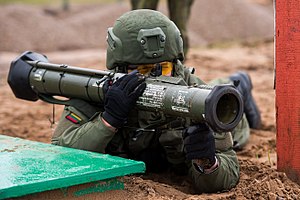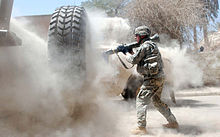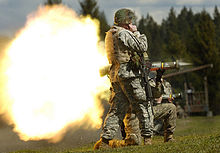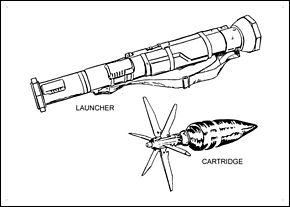AT4
| AT4 | |
|---|---|
 | |
| Type | Disposableanti-tanklauncher |
| Place of origin | Sweden/United States |
| Service history | |
| In service | 1987–present |
| Used by | SeeOperators |
| Wars | SeeWars |
| Production history | |
| Designer | Förenade Fabriksverken |
| Manufacturer |
|
| Unit cost | US$1,480[1] |
| No.built | 600,000+[2] |
| Variants | SeeVariants |
| Specifications | |
| Mass | 6.7 kg (14.8lb) (AT4)[3] 8 kg (18 lb) (AT4-CS) |
| Length | 102 cm (40 in)[3] |
| Caliber | 84 mm |
| Muzzle velocity | 290 m/s (950 ft/s; 1,000 km/h), 220 m/s (720 ft/s; 790 km/h) (CS)[4] |
| Effective firing range | 300 m (point target)[3] |
| Maximum firing range | 500 m (area target) 2,100 m (maximum) |
| Sights | Iron sights,optionalAN/PVS-4night visionunit |
| Filling | Octol |
| Filling weight | 440 ghigh-explosive anti-tank(HEAT) round |
| External images | |
|---|---|
| Prototype AT4 Sweden tested 1981/82 | |
TheAT4[a]is a Swedish 84 mm (3.31 in) unguided, man-portable, disposable,shoulder-firedrecoillessanti-tank weaponmanufactured bySaab Bofors Dynamics(formerly: FFV Ordance, later, Bofors Anti-Armour Systems).[5][unreliable source?]The AT4 is not arocket launcherstrictly speaking, because the explosive warhead is not propelled by arocket motor.Rather, it is a smooth-bore recoilless gun (as opposed to arecoilless rifle,which has arifledbarrel).[6]Saabhas had considerable sales success with the AT4, making it one of the most common light anti-tank weapons in the world.[7][8]TheM136 AT4is a variant used by theUnited States Army.
The name AT4 is a word play on the 84 mmcaliberof the weapon, (84) 'eighty four' being ahomophoneof 'A-T-4'.[9]The name also doubles as an Alpha -phonetic word play on the weapon's role, due to "AT" being a common military abbreviation for "anti-tank".[10]The name was created for export purposes as the nickname "eighty-four" was already a common English nickname for theCarl Gustaf 8.4 cm recoilless rifleafter its caliber.[9]
The AT4 is intended to giveinfantryunits a means to destroy or disablearmoured fighting vehiclesandfortifications,although it is generally ineffective against more modernmain battle tanks(MBTs), especially those withreactive armour,unless weaker sections of armour are exploited. The launcher and projectile are manufactured prepacked and issued as one unit of ammunition, with the launcher discarded after one use.
Development
[edit]The AT4 is a development of the 74-mmPansarskott m/68[11](Miniman) adopted by theSwedish Armyin the late 1960s. Like the m/68, the AT4 was designed byFörenade Fabriksverken(FFV) and manufactured at their facility at Zakrisdal,Karlstad,Sweden.[5]FFV began research on a replacement for the m/68 in 1976, deliberately designing an individual anti-armour weapon that would not be able to defeat the heavy armour protection of MBTs (main battle tanks) in frontal engagements, believing that to be counterproductive. The AT4 was designed as a weapon to engage medium-to-light armoured vehicles from any direction or MBTs from the sides or rear, and as an assault weapon effective against buildings and fortifications. FFV's prime design goal was a weapon that was simple to use, rugged, and far more accurate against moving targets than previous individual antiarmour weapons. Another key requirement was that the AT4 not only be able to penetrate armour, but also exhibit devastatingbeyond-armour effectafter penetration. FFV and the Swedish Army began the first evaluation firings of the prototype AT4s in the spring of 1981, with 100 tested by early 1982.[12]
Even before the AT4 had been adopted by Sweden, it was entered into aUnited States Armycompetition for a new anti-tank weapon mandated by Congress in 1982 when theFGR-17 Viperfailed as a replacement for theM72 LAW.Six weapons were tested in 1983 by the US Army: the BritishLAW 80,the GermanArmbrust,the FrenchAPILAS,the Norwegian M72E4 (an upgraded M72 LAW), the US Viper (for baseline comparison purposes) and the Swedish AT4. The US Army reported to Congress in November 1983 that the FFV AT4 came the closest to meeting all the major requirements established to replace the M72 LAW,[13]with the Armbrust coming in second.[14]
Though very impressed with the simplicity and durability of the tested version of the AT4, the US Army saw some room for improvement, specifically the addition of rear and front bumpers on the launch tube and changes to the sights and slings. After these changes, the AT4 was adopted by the US Army as theLightweight Multipurpose WeaponM136.[15]The Swedish Army also recognized these improvements and subsequently adopted the Americanized version of the AT4 as thePansarskott m/86(Pskott m/86), with the addition of a forward folding hand grip to help steady the AT4 when being aimed and fired. The forward folding grip is the only difference between the AT4 adopted by Sweden and the US Army version.
Due to the urban combat conditions that US military forces faced regularly during theIraq War,the US Army Close Combat Systems manager in charge of purchases of the AT4 suspended orders for the standard version of the AT4; US military forces instead only ordered the AT4 CS (Confined Space) version.[16]
Operation
[edit]This sectionneeds additional citations forverification.(November 2021) |

The AT4 may be considered a disposable, low-cost alternative to aCarl Gustaf 8.4 cm recoilless rifle.The AT4 took many of its design features from the Carl Gustaf, which operates on the principle of arecoilless weapon,where the forwardinertiaof theprojectileis balanced by the inertia ofpropellantgases ejecting from the rear of the barrel. But unlike the Carl Gustaf, which uses a heavier and more expensive steel tube withrifling,[17]the disposable AT4 design greatly reduces manufacturing costs by using a reinforced smoothborefiberglassouter tube. Being a disposable gun also allows for lighter and cheaper construction. In a single-use disposable gun, the barrel only needs to be able to contain a single pressure spike when firing, when it can be disposed of, even if it is ruined, burnt-out and strained, unlike traditional guns which are required to survive many pressure spikes without failure and thus need to be strongly overbuilt and made of heat-proof materials. Pressures are also kept quite low compared to many traditional guns. This lightweight and thin barrel and low pressure, combined with the almost complete lack of recoil, means that relatively large projectiles (comparable to those found inmortarsandartillerysystems) can be utilised, which would otherwise be impossible in a man-portable weapon.
In the system originally developed by FFV for the Carl Gustaf, a plastic blowout plug is placed at the centre rear of the shell casing containing the projectile and propellant, which itself is enclosed in the AT4 outer tube. When the gases build up to the correct pressure level, the blowout plug disintegrates, allowing the proper amount of gases to be vented to the rear, balancing the propellant gases pushing the projectile forward.
The AT4 adopted a unique method developed earlier by FFV: the spring-loaded firing rod is located down the side of the outer tube, with thefiring pinat the rear of the tube. When released, the firing pin strikes a primer located in the side of the casing's rim.


The disadvantage of the recoilless design is that it creates a largeback blastarea behind the weapon, which can cause severe burns andoverpressureinjuries to friendly personnel in the vicinity of the user and sometimes even to the users themselves, especially in confined spaces. The back blast may also reveal the user's position to the enemy. The problem of back blast was solved with theAT4-CS(Confined Space) version, specially designed forurban warfare.This version uses a saltwater countermass in the rear of the launcher to absorb the back blast; the resulting spray captures and dramatically slows down the pressure wave, allowing troops to fire from enclosed areas. The AT4-CS version also reduced its muzzle velocity from the original 290 m/s to 220 m/s as part of its effort to be user-safe in a confined space, making the AT4-CS version more difficult to use as the drop is more pronounced. The effectiveness of the HEAT warhead is not dependent on speed.[citation needed]
To fire, the gunner first removes the safety pin located at the rear of the tube, which unblocks the firing rod. They then take a firing position, ensuring that no one is present in the back blast area. If firing from theprone position,they must also place their legs well to the side to avoid burning himself. Then, the gunner moves back the front and rear sight covers, allowing the sights to pop up into their firing positions. The AT4 hasiron sightsthat were originally developed for the cancelledViper,and are similar in concept and use to those on assault rifles.[18]They then remove the first of twosafetiesby moving the firing rod cocking lever (located on the left side) forward and then over the top to the right side. The gunner takes aim, while at the same time holding down the red safety lever located in front of the cocking lever, and then fires by pressing forward the red firing button with his right thumb. Both the red safety lever and the firing button must be pressed down at the same time to fire the AT4. The red firing button has a similar resistance to the trigger pull of a rifle, so the gunner does not have to jab at the firing button, which could throw their aim off.

After firing, the AT4 is discarded. Gunners are often trained to break off the sights after use, in order to prevent other soldiers from mistaking used launchers for unused ones. Unlike the heavier Carl Gustaf, the AT4 outer tube is built to take the stress of just one firing; it is not reusable and cannot be reloaded.
The AT4 can mount an opticalnight sighton a removable fixture. In US military use, the launcher can be fitted with the AN/PAQ-4C, AN/PEQ-2, or the AN/PAS-13 night sights.
The AT4 requires little training and is quite simple to use, making it suitable for general issue. However, as the cost of each launcher makes regular live-fire training very expensive, practice versions exist that are identical in operation but fire reloadable9×19mmor20mmtracer ammunition.Both practice cartridges are unique to their respective weapons, with their trajectory matched to that of the live round. The 20mm version also has arecoilless weaponeffect with the same high noise and back blast as the AT4 firing and is favoured by the Swedish army because of the added realism of the back blast as compared to the "plonk" sound of the 9mm round (similar to the sound of a finger tapping on an empty can).
Specifications
[edit]- Time of flight (to 250 metres (820 ft)): less than 1 second[citation needed]
- Operating temperature:−40–60 °C (−40–140 °F)[citation needed]
- Ammunition: fin-stabilized projectile with HEAT warhead[citation needed]
Projectiles
[edit]There are several different projectiles for the AT4. Because it is a one-shot weapon, projectiles are preloaded into the launcher tubes.[5]

High-explosive anti-tank(HEAT) – Can penetrate up to 45 centimetres (18 in) ofrolled homogeneous armour(RHA) withbeyond-armour effect.[19]
High-explosive dual purpose(HEDP) 502[5][20]– For use againstbunkers,buildings, enemy personnel in the open, and light armour. It can be set to detonate on impact or with a brief detonation delay. The heavier nose cap allows either to penetrate light walls or windows before exploding, or to be "skipped" off the ground for an air burst. For use against light armour, there is a smaller-cone HEAT warhead with 15 centimetres (5.9 in) penetration of RHA.
High penetration(HP) – Extra high penetration ability, up to 42–60 centimetres (17–24 in) of RHA.[21]
Anti-structure tandem-warheads(AST) – Designed for urban warfare where a projectile heavier than the HEDP AT4 is needed. This combines a shallow-coned HEAT warhead (resulting in low penetration but producing a wide hole) with atandem-chargeand a follow-through high-blast warhead. It has two settings: either to destroy bunkers or tomouse-holea building wall for combat entry.[22]
Extended range(ER) – Anti-armor version with HEAT warhead. Range is extended from 300 to 600 metres (980 to 1,970 ft), with increased penetration up to 46 centimetres (18 in) of RHA. These major improvements add only about 2 kilograms of mass, despite being CS models.[23][21]
High explosive(HE) – High explosive anti-personnel weapon that can be set for impact orair-burstdetonation, with an effective range up to 1,000 metres (3,300 ft).[23]
Variants
[edit]M136 AT4– American version with modified launch tube bumpers, sights, and slings.[24]
XM919 Individual Assault Weapon (also known as AT4CS TW) –American future variant, to enter service in 2025, and be delivered by 2029 for USD $500 million.[25]
Bunker-busting(AT8) – An AT4 version where the standard HEAT projectile is replaced with the bunker-busting warhead developed for theMk 153 Shoulder-Launched Multipurpose Assault Weapon(SMAW). No orders were ever placed.[26]
AT12-T– In the early 1990s, there were tests of atandem charge120 mm version (Bofors AT 12-T). The 14 kg weapon had a claimed penetration of 90 centimetres (35 in) RHA,[27]and in 1994 was demonstrated to defeat two NATO Single Heavy targets inclined at 68 degrees from vertical with ERA,[28]for a line-of-sight penetration of 600 mm. However, the project was cancelled due to the dissolution of theSoviet Unionand the subsequent cuts in Western defence budgets.[citation needed]
Operators
[edit]

 Argentina:Argentine Army[29]andArgentine Marines[30]
Argentina:Argentine Army[29]andArgentine Marines[30] Bosnia and Herzegovina[5]
Bosnia and Herzegovina[5] Brazil[31]
Brazil[31] Canada:JTF2[5]
Canada:JTF2[5] Chile:Chilean Marine Corps,Chilean Army[5]
Chile:Chilean Marine Corps,Chilean Army[5] Colombia[5]
Colombia[5] Croatia[31]
Croatia[31] Denmark:DesignatedPVV M/95(PanserværnsvåbenModel 1995).[32]: 93
Denmark:DesignatedPVV M/95(PanserværnsvåbenModel 1995).[32]: 93  Dominican Republic
Dominican Republic Finland
Finland France:DesignatedABL(AntiBlindéLourd) by theFrench Army.[33]
France:DesignatedABL(AntiBlindéLourd) by theFrench Army.[33] Georgia[31]
Georgia[31] Greece:Used by Hellenic Navy Seals[5]
Greece:Used by Hellenic Navy Seals[5] India[34]
India[34] Indonesia[35]
Indonesia[35] Iraq:TheIraqi Armywas supplied with the AT4.[36][37]
Iraq:TheIraqi Armywas supplied with the AT4.[36][37] Kurdistan:ThePeshmergaHave Between 1,000-15,000 AT-4's.[38]
Kurdistan:ThePeshmergaHave Between 1,000-15,000 AT-4's.[38] Ireland:Called theSRAAW(Short Range Anti Armour Weapon) by theIrish Defence Forces.[32]: 139
Ireland:Called theSRAAW(Short Range Anti Armour Weapon) by theIrish Defence Forces.[32]: 139  Jaysh al-Islam(Captured from the Syrian Democratic Forces)[39]
Jaysh al-Islam(Captured from the Syrian Democratic Forces)[39] Kurdistan Workers' Party[40][41]
Kurdistan Workers' Party[40][41] Latvia[42]
Latvia[42] Lebanon:Roughly 1,000 pieces purchased.[43]
Lebanon:Roughly 1,000 pieces purchased.[43] Lithuania:Lithuanian Armed Forces[44]
Lithuania:Lithuanian Armed Forces[44] Malaysia:In service with theGrup Gerak Khas[5]
Malaysia:In service with theGrup Gerak Khas[5] Mexico
Mexico
 Netherlands[46](Replaced byPzf-3)
Netherlands[46](Replaced byPzf-3) Poland(limited use in Special Operations Forces and Air Mobile Forces)[47]
Poland(limited use in Special Operations Forces and Air Mobile Forces)[47] Sweden:DesignatedPansarskott m/86.[31]
Sweden:DesignatedPansarskott m/86.[31] Syrian Democratic Forces
Syrian Democratic Forces Taiwan (Republic of China)[5]
Taiwan (Republic of China)[5] United Kingdom:Small quantities of AT4 and HP projectiles purchased.[2][5]
United Kingdom:Small quantities of AT4 and HP projectiles purchased.[2][5] Ukraine:15,000 supplied by Sweden,[48][49]6,000 supplied by the United States,[50]both in 2022.
Ukraine:15,000 supplied by Sweden,[48][49]6,000 supplied by the United States,[50]both in 2022. United States:DesignatedM136 AT4inUSMCandUnited States Armyservice, beginning in early 1987.[51]The AT4 was used in theUS invasion of Panama,theWar in Afghanistan,thePersian Gulf War,and theIraq War.[52]Over 300,000 have been built locally, under license byATK.[2][5]
United States:DesignatedM136 AT4inUSMCandUnited States Armyservice, beginning in early 1987.[51]The AT4 was used in theUS invasion of Panama,theWar in Afghanistan,thePersian Gulf War,and theIraq War.[52]Over 300,000 have been built locally, under license byATK.[2][5] Venezuela:The AT4 has been in the Venezuelan arsenal since the 1980s.[31][53]In 2009, it was reported that AT4s sold to Venezuela had been captured fromFARCinsurgents in Colombia, leading Colombia to accuse Venezuela of selling the weapons to the insurgents, and Venezuela reporting that they were stolen by a rebel attack on a Venezuelan position in 1995,[54]thus heightening tensions between the two countries.[53][55]
Venezuela:The AT4 has been in the Venezuelan arsenal since the 1980s.[31][53]In 2009, it was reported that AT4s sold to Venezuela had been captured fromFARCinsurgents in Colombia, leading Colombia to accuse Venezuela of selling the weapons to the insurgents, and Venezuela reporting that they were stolen by a rebel attack on a Venezuelan position in 1995,[54]thus heightening tensions between the two countries.[53][55]
Wars
[edit]- US invasion of Panama[52]
- Kurdish–Turkish conflict (1978–present)
- Soviet–Afghan War
- Gulf War
- Afghanistan War[52]
- Iraq War[52]
- Second Ivorian Civil War[56]
- Mali War[57]
- 2013 Lahad Datu standoff
- War in Iraq (2013–2017)
- Syrian Civil War
- 2022 Russian invasion of Ukraine
See also
[edit]- List of rocket launchers
- List of anti-tank missiles
- ALAC (Arma Leve Anticarro)
- Alcotan-100– (Spain)
- APILAS– (France)
- B-300– (Israel)
- DZJ-08– (China)
- LAW 80– (United Kingdom)
- MARA (anti-tank weapon)– (Argentina)
- MATADOR– (Singapore)
- NLAW– (Sweden, United Kingdom)
- Panzerfaust 3– (West Germany)
- RPG-76 Komar– (Polish People's Republic, Poland)
- RPG-75– (Czechoslovakia)
- Urban Assault Weapon– (United States)
- M141 Bunker Defeat Munition– (United States)
- Kestrel (rocket launcher)– (Taiwan)
References and notes
[edit]Explanatory footnotes
[edit]- ^Sometimes also spelled AT-4 or AT 4.
Citations
[edit]- ^M136 AT4,FAS,archivedfrom the original on 3 April 2007,retrieved3 April2007
- ^abcKemp, Ian (April–May 2006), "The law gets tougher: the shoulder-launched light anti-armour weapon has evolved to become a multipurpose assault weapon much in demand for asymmetric warfare",Armada International,ISSN0252-9793
- ^abcMcManners, Hugh (2003).Ultimate Special Forces.DK Publishing.ISBN0-7894-9973-8.
- ^Owen, William F. (2007)."Light Anti-Armour Weapons: Anti-Everything?"(PDF).Asian Military Review.Archived fromthe original(PDF)on 7 July 2011.Retrieved12 May2010.
- ^abcdefghijklm"AT4 Light Anti-Armour Weapon".Army Technology. 30 April 2018.Archivedfrom the original on 7 May 2016.
- ^"84mm M136 (AT-4) Projected Grenade".Collective Awareness to UXO.Archived fromthe originalon 3 August 2022.Retrieved3 August2022.
- ^Atlamazoglou, Stavros (20 February 2024)."AT4: NATO Orders Proven Anti-Tank Weapon Used in Ukraine".The National Interest.Retrieved15 April2024.
Made in Sweden by SAAB, the AT-4 is one of the most successful weapons in its category, with over a million sales.
- ^"France buys AT4 man-portable anti-tank weapon".mil.in.ua.28 January 2023.Retrieved15 April2024.
Currently, the AT4 is one of the most popular and successful man-portable, disposable anti-tank weapon in the world.
- ^abÅkerström, Linda (2018).Den svenska vapenexporten.Sweden: Leopard Förlag. p. 72.ISBN9789173438384.
- ^Hewish, Mark, "FFV's Lightweight AT4, first of a new family of Swedish anti-armour weapons"International Defense Review,May 1980, p. 70.
- ^Pansarskottis a Swedish term that roughly translates to "armour shot".
- ^International Defense Review,May 1980, p. 71.
- ^The French APILAS was the only tested weapon that had the maximum penetration to defeat the frontal armour of the new Russian T-72 MBT, but it was rejected due to its weight and size.
- ^The Armbrust, while an impressive weapon with its almost total lack of launch signature, which enabled it to be fired from enclosed spaces, was rejected due to higher cost and lack of effective range against moving targets.
- ^The U.S. Army had so much grief in the early 1980s from various committee members of the U.S. Congress over the M72 LAW being officially referred to in manuals as a LightAntitankWeapon that they named the AT4 to make sure no member of Congress could question that again.
- ^John Antal. "Packing a Punch: America's Man-Portable Antitank Weapons". page 90.Military Technology.March 2010. ISSN 0722-3226.
- ^Until the 1980s the Carl Gustaf was constructed of high-alloy steel, but later versions used a thin steel liner containing the rifling, strengthened by acarbon fibreouter sleeve.
- ^FFV and the Swedish Army were so impressed by these sights that they adopted them for their AT4s; while adequate during the day, the original plastic sights were difficult to see at night or under low light conditions.
- ^"An Infantryman's Guide to Combat in Built-Up Areas"(PDF).bits.de.3 October 1995.Retrieved10 April2023.
- ^the complete disposable launcher and HEDP projectile is referred to by the manufacture in brochures as the LMAW (light multipurpose-assault weapon) see external links for link on early photos and press releases for further information on brochure
- ^ab"AT4 Family | Saab".
- ^"2008 SAAB video on AT4 versions including new multipurpose warhead for urban combat".YouTube.14 August 2008.Archivedfrom the original on 18 October 2014.Retrieved11 October2014.
- ^abSaab to integrate new projectile variants for disposable shoulder-launched rocket systemArchived24 December 2016 at theWayback Machine- Janes, 11 June 2014
- ^"AT4 Light Anti-Armour Weapon - Army Technology".Archivedfrom the original on 31 July 2018.
- ^"AT4CS TW wird die zukünftige Individual Assault Munition der U.S. Army"(in German). 28 August 2024.Retrieved29 August2024.
- ^Jane's Infantry Weapons 1995–96, page 220. The reference refers to Allaint Techsystems as the manufacture, but they soon after were acquired by Honeywell. TheSMAW-Doffered by Talley was chosen for the U.S. Army program that the AT4 entered. See external images at the SMAW-D link for an arms brochure on theFFV AT8
- ^"Small Arms Archive Detail Page for S00437".
- ^"Bofors demo 92 2-4".YouTube.13 December 2011.
- ^"Carl Gustaf, AT-4CS y fusiles Steyr HS.50 M1 para el Ejército Argentino".27 October 2017.Archivedfrom the original on 29 October 2017.Retrieved29 October2017.
- ^"La Infantería de Marina adquirió armamento antitanque descartable".Archived fromthe originalon 2 November 2010.Retrieved25 October2010.
- ^abcdeJones, Richard D (27 January 2009),Infantry Weapons 2009/2010(35 ed.), Jane's Information,ISBN978-0-7106-2869-5
- ^ab"The World Defence Almanac",World Defence Almanac: The Balance of Military Power,2000,ISSN0722-3226
- ^Replaced theAPILAS:AT 4 CS – L'arme anti blindé lourd AT 4 CS – The anti-heavy armor weapon,France: Ministry of Defense,archivedfrom the original on 8 January 2014,retrieved29 June2013
- ^"Saab Awarded Indian Contract for AT4 Support Weapon".Saab.Archivedfrom the original on 20 January 2022.Retrieved27 January2022.
- ^"AT-4 Senjata Andalan Unit Infanteri".Radarmiliter(in Indonesian).Retrieved16 May2022.
- ^"Swedish weapons in the Iraqi military?",Radio Sweden,18 November 2010,archivedfrom the original on 19 February 2011,retrieved18 November2010
- ^Vining, Miles (19 June 2018)."ISOF Arms & Equipment Part 4 – Grenade Launchers & Anti-Armour Weapons".armamentresearch.Archivedfrom the original on 28 July 2018.Retrieved31 July2018.
- ^International Institute for Strategic Studies(February 2016).The Military Balance 2016.Vol. 116. Routledge. p. 491.ISBN9781857438352.
- ^"Archived copy".pbs.twimg.Archived fromthe originalon 8 November 2019.Retrieved11 January2022.
{{cite web}}:CS1 maint: archived copy as title (link) - ^"Northern Iraq PKK-Weapon Caches of Operation 'Claw Tiger'".Silah Report.27 August 2020.Retrieved27 May2021.
- ^sabah, daily (16 August 2017)."2 Swedish-made antitank missiles found in PKK hideout in Turkey's southeast".Daily Sabah.Retrieved27 May2021.
- ^"The World Defence Almanac",World Defence Almanac: The Balance of Military Power:172, 2010,ISSN0722-3226
- ^Kahwaji, Riad (13 November 2007)."Lebanon: Foreign Arms Vital to Hizbollah Fight"(JPEG).Defense News.Archivedfrom the original on 17 July 2011.Retrieved25 January2009.
- ^"Lietuvos kariuomenė:: Ginkluotė ir karinė technika » Granatsvaidžiai ir prieštankiniai ginklai » Prieštankinis granatsvaidis AT-4".Archivedfrom the original on 9 October 2014.Retrieved11 October2014.
- ^"Rusia alerta a México: lanzacohetes de cárteles es de los enviados por EU a Ucrania".31 May 2023.Retrieved31 May2023.
- ^"The World Defence Almanac",World Defence Almanac: The Balance of Military Power:105, 2005,ISSN0722-3226
- ^"Polish Army Photogallery".Polish Ministry of Defence. Archived fromthe originalon 17 July 2011.Retrieved26 April2010.
- ^"Mer svenska vapen till Ukraina".Sydsvenskan(in Swedish). 23 March 2022.Retrieved23 March2022.
- ^Nilsson, Maja (2 June 2022)."Sverige bistår Ukraina med sjömålsroboten Robot 17".SVT Nyheter(in Swedish).Retrieved2 June2022.
- ^Collins, Kaitlan; Liptak, Kevin; Mattingly, Phil; LeBlanc, Paul; Vazquez, Maegan (17 March 2022)."Biden announces hundreds of millions in new security aid for Ukraine following Zelensky's speech".CNN.Retrieved25 April2022.
- ^"Modernizing and Equipping the Army".Department of the Army Historical Summary, FY.United States Army Center of Military History.1987. p. 43. CMH Pub 101-19.Archivedfrom the original on 21 September 2010.Retrieved13 August2010.
- ^abcdVapenexport(PDF),SE: Svenskafreds[permanent dead link]
- ^ab"Global Security - News and Defence Headlines - IHS Jane's 360".IHS Jane's 360.Archivedfrom the original on 10 March 2011.Retrieved11 October2014.
- ^"Presentan video del ELN con armas de Cararabo - Internacional - EL UNIVERSAL".eluniversal.Archived fromthe originalon 8 December 2015.Retrieved29 November2015.
- ^"Colombia and Venezuela face off".GlobalPost.Archivedfrom the original on 18 October 2014.Retrieved11 October2014.
- ^Richard, Christophe (2014)."Battle of Abidjan: accurate and timely fires"(PDF).Fantassins.No. 32. p. 28. Archived fromthe original(PDF)on 15 December 2018.Retrieved13 December2018.
- ^Capdeville, Thibault (Spring 2014)."Infantry units fires during OP Serval"(PDF).Fantassins.No. 32. pp. 55–58. Archived fromthe original(PDF)on 15 December 2018.Retrieved13 December2018.
External links
[edit]- Official website,covers the different versions
- Saab AT4 PDFArchived19 September 2016 at theWayback Machine
- AT4 – Saab Bofors Dynamics video of various AT4 versions
- AT4 Information Page – Modern Firearms
- Swedish article on AT4 translated to English
- U.S. Army field manual 3–23.25
- Brazilian newspaper recorded a AT-4 at Rocinha slum (translated to English)


